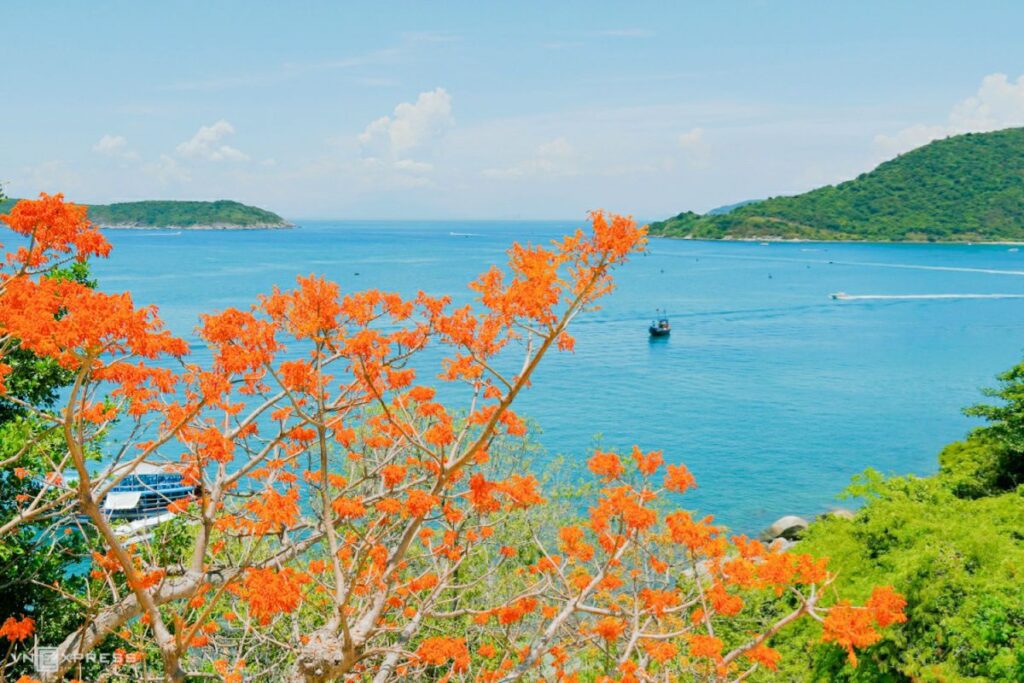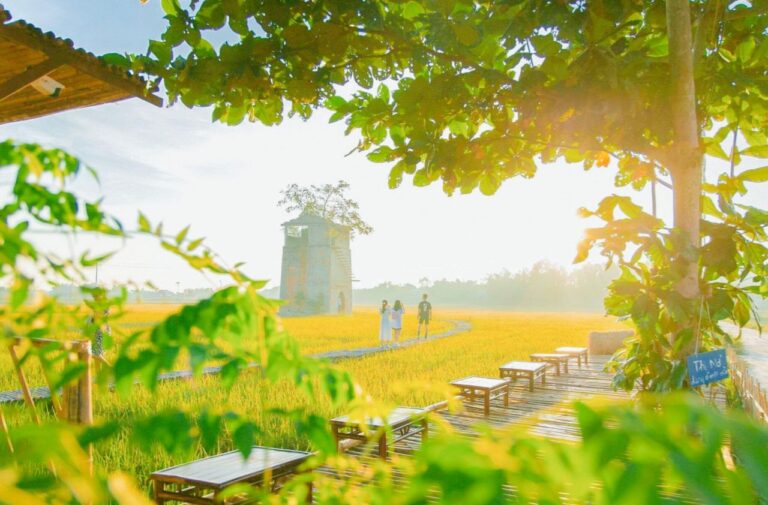The old-world charm of Hoi An, with its quaint red-brick houses, gilded walls, traditional meeting halls and handicraft villages, is a journey into the heart of a bespectacled time machine – an ancient past.
Distinctive and varied cuisine complements Hoi An’s notable attractions.

Best time to visit in Hoi An
Hoi An enjoys a warm climate all year round with an average temperature of 29 degrees Celsius.
The maximum temperatures are between June and August when daytime temperatures can reach 38 degrees Celsius.
February to April is the ideal time to visit Hoi An with perfect weather. The rainy season from September to January, a time of thunderstorms and flooding, particularly in October and November, is reserved for the intrepid traveler who is not afraid of the weather.
Some of them said that navigating the city’s flooded streets during flood season is an experience not to be missed.

What to explore in Hoi An
Day 1: Japanese Pagoda Bridge – Hoi An Assembly Hall – Hoai River

The Japanese Pagoda Bridge is the symbol of Hoi An and appears on the VND 20,000 banknote.
Located in the heart of the old town, the bridge was completed in the early 17th century by the Japanese. A small temple was built at one end of the bridge in 1653 to worship weather gods, who were believed to prevent disasters and bring good luck and fortune to the people. Many people called it Chua Cau.
Unfortunately, the bridge is not in good condition, having been damaged by the sewage below.
Some experts warned that there was a risk of sinking. Local authorities have approved a VND 20 billion (US$860,000) rehabilitation plan to prevent the 400-year-old bridge from collapsing.
Frequented by Chinese traders in the 16th and 17th centuries, the rows of Chinese-sounding assembly halls with red-tiled roofs and dragon-carved walls are a unique feature that sets Hoi An apart from other cities.
The Assembly Hall of the Cantonese Congregation, built in 1885, is located in the city center.
This wood and stone hall houses many ceramic artifacts that reflect the culture of the Cantonese community that once ruled the city.



Located at Tran Phu 46, Fujian Assembly Hall is the largest and most famous traditional architecture. Visitors light large garlands of incense and often hang cards with prayers for health and prosperity.
The Trieu Chau Assembly Hall was built in 1845 by the Chaozhou community to worship the sea god and bless the voyage with peace and smooth sailing.
Architectural motifs with popular legends decorate the room, many of which are engraved in porcelain.
Quan Cong (Quan Yu) Temple, which worships the god Guan Yu, who served under warlord Liu Bei in the late Eastern Han Dynasty, is famous for its outstanding Chinese architecture with roofs tiles, red lanterns and carved wooden sculptures.

At night, the Hoai River, a tributary of the Thu Bon River, where Hoi An blooms on both sides, is busier than ever. Many locals make a decent living by offering river cruises on their boats for 200,000-250.000 VND.
During the boat ride, visitors can throw colorful lanterns on the calm water and make wishes. A lantern costs from 15,000 VND or more. As soon as tourists approach the Hoai River, many street vendors offer boating services and release lanterns. Prices can vary depending on the number of people in a group, so haggle a bit to find the best deal.
A boat can carry up to five passengers and each trip usually takes 15 to 20 minutes.
Anh Minh Thien, a local smuggler, said his family had been transporting tourists along the Hoai River for more than 10 years, but those two years were almost their main source of income due to the epidemic.
If a boat ride doesn’t attract visitors, the one-hour program called “Memories of Hoi An” is a great alternative.
With 500 actors, the show was performed on a 25 square foot outdoor stage at Hoi An Impression Theme Park on Hen Islet, Cam An Ward.

“Hoi An Memories” takes place every day of the week except Tuesday from 8:00 p.m. to 9:00 p.m.
Ticket prices range from 480,000 to 1.2 million VND (20.58-51.45 USD).
Day 2: Bike Tour – Bay Mau nipa Palm Forest – Traditional Craft Village

A 5-hour bike tour, priced at $19.5 per person, allows visitors to observe the performance of locals . cycling around the island of Duy Vinh, 5 km from the city center.
Visitors can book tours at Heaven and Earth Bicycle Tours on Ngo Quyen Street.
From the center of Hoi An, you can rent bicycles from the hotel and ride less than 5 km to Bay Mau Nipa forest and join boat trips.



The 45-minute visit costs 150,000 VND/person, including the entrance fee to the forest. Crab fishing and stuntmen performing a unique coracle dance are part of the tour.
During the tour, visitors can also try their hand at fishing and enjoy fresh seafood dishes.
Visitors who want to explore the forest but don’t want to get in the water can also rent a motorbike for around $5 a day, or ask the hotel for free bikes.

“All in all, it’s worth it, but I recommend going early before the tour groups take over,” American traveler Jason told VnExpress International.
Currently, travel agencies in Hoi An offer day trips to Bay Mau Nipa forest and traditional craft villages, including local delicacies, at VND 600,000 per person.
Tra Que Village, three kilometers from the center of Hoi An, is famous for its fresh vegetables grown in fertile soil and is a great place to visit. guests can not only get information about vegetables and crops, but can directly participate in plowing, sowing and harvesting of vegetables. Then they can enjoy Hoi An specialties with fresh seafood such as clams and prawns and thick kwang noodles.
Near Tra Que is the 15th century pottery village of Thanh Ha. Located 2 miles west of Hoi An on the banks of the Thu Bon River, this village is home to dozens of families who have been making unique pots, bricks, plates, utensils and gifts for generations.
Spectators can not only watch the techniques of masters, but also try to make their own ceramic products. Kim Bong Carpentry Village is famous for its unique wooden products for houses, boats, modern decorations and gifts, Phuoc Kieu Bronze Village has existed for four centuries.


Day 3: Cham Island

Cu Lao Cham is a popular tourist attraction and offers additional attractions such as diving and water tourism. Since the island is very close to the mainland, it is ideal for a day trip.
From Hoi An, reach Cu Lao Cham in 20 minutes by speed boat for 150,000-200.000VND/person. If you want to save money, you can pay VND 50,000-80,000 ($2-4) for a regular boat ride from Bach Dang Wharf, but the trip takes about two hours. An additional fee of 30,000 VND ($1.30) is charged for boarding the plane.


A night in Cu Lao Cham costs 100,000-150,000 VND ($4-6) for a single room. A tent also costs about 100.000 VND ($4.32) per night.
Snorkeling is popular here because the coral reef is only two meters underwater.
Interested visitors are taken to designated dive sites and provided with the necessary equipment.
Cham Island has a small pagoda currently maintained by an elderly couple where visitors can enjoy a sense of peace and tranquility.
Where to stay in Hoi An




B&B business is booming in Hoi An and is well-known all over the world. A homestay in Hoi An can be an interesting experience due to its unique architecture and interior design. Year-round room rates exceed VND 200,000 per person per night. b
Affordable homestay options include Vinh Hung Homestay, Coconut Village, An Bang Beach Hideaway, Heron House and Hai Yen Homestay. The design of the Boutique Hotel is inspired by local architecture, with golden roofs and walls. These include the Palm Garden Resort, Almanity Hoi An Resort & Spa, Silk Sense Hoi An River Resort & Spa and Lasenta Boutique Hotel.
What to eat in Hoi An

Once a melting pot of Asian traders, it’s no surprise that Hoi An has a rich and varied cuisine with many influences.
The most famous dish turned into meat in Hoi An is Cao Lau (Vietnamese thick noodles), made with boiled noodles, beans and herbs from the famous village of Tra Que.
There are thin slices of fried pork and pork skin on the plate. A bowl of cao lau is available almost anywhere in Hoi An, but try Cao Lau Thanh on Thai Phien Street or Cao Lau Ba Be on Tran Phu Street.
A delicious bowl of Cao Lau costs about $1.



Travel bloggers say that chicken rice is another must-try dish in Hoi An. A plate of shredded or shredded chicken costs about VND 40,000 ($1.77).
The most famous courts for this popular dish are Madam Buoi on Phan Chu Trinh Street and Madam Huong on Le Loi Street.
Banh mi (Vietnamese bread), which has become an important part of Vietnamese street food, has a unique image in Hoi An.
Hoi An bread is filled with pork, pastry, homemade sauce, hot peppers, herbs and pickled carrots. Madam Phuong and Madam Hanh are the most popular local restaurants serving typical Vietnamese sandwiches in Hoi An and are widely mentioned in foreign media.
A regular baguette costs 20,000 dong (less than $1), but a special edition is available for an additional 5,000 dong.
Along Tran Phu Road to the corner of Le Loi, Tran Hung Dao, Bach Dang, you can see delicious kebabs everywhere. Roasted meat wrapped in thin rice, served with herbs and carambola slices, is another dish that is best paired with special sauces. A skewer can be had for just VND 5,000 (about 22 cents).
Hoi An’s water fern cake, made of rice noodles, shrimp paste and fried pork skin, usually cooked and served in small bowls. The chefs add chili fish sauce to make the dish more enjoyable. The most popular places to find this dish are in Cam Chau and Cam Nam districts or Hoi An market.
Each bowl of this delicious dish is only VND 3,000 (US 13 cents).
A scene of customers around street vendors selling rice cakes is often seen along the banks of the Hoai River in the evening. A bowl of tofu with sweet and spicy ginger fish sauce, white jelly and coconut milk costs about 15,000 VND.
How to get to Hoi An

Has direct flights to Da Nang from Hanoi and Ho Chi Minh City, with round-trip airfare starting at VND 1.5 million per person.
After arriving at Da Nang Airport, you can take a shuttle bus or Grab car bus or car to Hoi An, which is about an hour away from the center of Da Nang.
There is a daily bus from Da Nang to Hoi An, and the fare is VND 20,000 per person.
Getting around Hoi An is easy by renting a bicycle or motorbike, most hotels and motels offer this service. Renting a bicycle or motorbike costs approximately VND 30,000 and VND 120.000 respectively dong per day.



